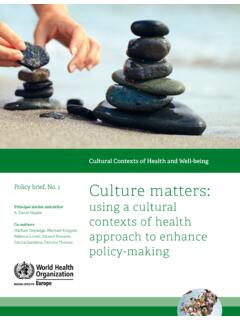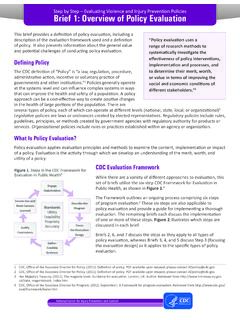Transcription of Making space: how public participation shapes ...
1 Stockholm Environment Institute 1 Making space: how public participation shapes environmental decision-makingKey messages Civil society engagement is key to achieving sustainable development and environmental goals. Governments cannot reach environmental protection goals alone they need support and guidance from the public . Increased public participation builds a more engaged citizenry, increases the legitimacy of decisions, and helps ensure that policy-makers have valuable local knowledge. public participation in environmental decision- Making includes both formal participation processes ( invited spaces ) and mobilization by engaged citizens ( created spaces ). Policy-makers should invest resources in the capacity building necessary to facilitate equitable and inclusive participation . Policy-makers should strive towards transparency in how input is applied to improve the legitimacy of public participation participation in sustainability and environmental protection is critically important.
2 This is reflected in the 2030 Agenda for Sustainable Development, which was created using unprecedented public outreach. More than million people from over 190 countries participated in the United Nations global online survey on the 2030 Agenda (Fox and Stoett 2016). The need for fuller and more inclusive democratic participation is also embedded in the Sustainable Development Goals (SDGs) themselves: Goal 16 specifically calls for responsive, inclusive, and participatory and representative decision- Making at all levels (United Nations General Assembly 2015).Despite this commitment, coordinated action to improve public participation does not receive the same level of attention as some of the other SDGs such as building resilient infrastructure or encouraging sustainable consumption. That may change this year, as public participation will be a central topic at the 2019 High-Level Political Forum on Sustainable Development.
3 The theme for the forum is empowering people and ensuring inclusiveness and equity . This discussion brief provides an introduction for policy-makers, researchers, and others interested in better understanding both the promise and challenges associated with expanding public participation . We focus on the value of public participation for environmental decision- Making , but the principles outlined have relevance for sustainability more broadly. Drawing on literature from policy studies and a wide range of social sciences, we begin by summarizing the core rationales for increasing the role of the public in policy- Making processes. We also provide a framework for Making sense of the diverse array of participation spaces and mechanisms, both within and outside formal state procedures. Next, we turn to challenges, drawing particular attention to how social norms can undermine inclusive and equitable engagement.
4 Finally, we note areas for future discussion brief January 2019 Laura H. Berry Jessica KoskiCleo VerkuijlClaudia StramboGeorgia PiggotPhoto (above): HERO IMAGES / GETTY 2 Stockholm Environment InstituteRationales for expanding public participationFor many policy-makers and environmental advocates, public participation is an intrinsic good, regardless of outcome. Allowing impacted communities and other stakeholders to take part in decision- Making is a basic component of democracy (Rosenbaum 1978; Thomas 1990). Others view public participation as a means to an end. For example, public participation can improve the quality of decision- Making by providing decision-makers with additional, unique information on local conditions (L pez Cerezo and Garc a 1996; Newig 2007; Yearley et al. 2003). Local or lay knowledge plays an especially important role in implementing international commitments, like the 2030 Agenda on Sustainable Development.
5 While the 17 Sustainable Development Goals are global in scope, the actual policy development and implementation occurs at the national, regional and local level. Policy-makers must translate the global targets to reflect real-world conditions (Fenton and Gustafsson 2017). Top-down translation, without widespread public input, can lead to policies that disregard local priorities and specific development contexts (Fox and Stoett 2016). public participation can also improve policy implementation by increasing the legitimacy of the decision- Making process and, in so doing, reducing conflict. Multiple studies have demonstrated that whether or not the public accepts a decision hinges on whether or not the public sees the decision- Making process as fair (Bulkeley and Mol 2003; Lind and Tyler 1988; Newig 2007; Murphy 2004; Tyler 1990).
6 Engaging the public in decision- Making can help overcome deficits in democracy, such as distrust of political leaders, declining faith in public agencies, and low voter turnout (Dalton 2008; Newig 2007; Nye et al. 1997; Welp et al. 2009).In much the same way, public participation also addresses the distrust that results from the predominance of experts in environmental decision- Making . Scientific experts are vital to environmental policy- Making , given that many environmental problems, such as ozone depletion and climate change, are only visible through science and technology (Carolan 2004; Eden 1996; Yearley 1992). At the same time, heavy reliance on technical experts can re-cast political issues as solely scientific questions, obscuring other considerations from public debate, such as accountability, equity and other values. (Carter 2001; Dryzek 1997; Fung 2006; Habermas 1970).
7 Absent an explicit language and space for political debate, science becomes the target and subject of debate. This often leads to distrust and gridlock, as evident in climate change policy- Making (Ozawa 2006; Sarewitz 2004; Sarewitz 2011). Bringing the public into decision- Making has the potential to reinvigorate debate and move policy- Making , the ability of public participation to deliver on its myriad promises hinges on how governments and civil society translate ideals into practice. For example, public participation does not improve democratic practice if it is not inclusive. Likewise, public input does not improve the quality of decision- Making if the right people are not in the room ( , those with unique information) or decision-makers do not actually take that information into account (Newig 2007). Similarly, public participation can breed distrust and conflict if the public does not perceive the process as fair a difficult benchmark to define and analyze.
8 We return to this point in discussing the challenges to expanding public participation in practice: invited and created spacesThe broad call to expand public participation has led to a rapid proliferation of public meetings, advisory committees and other government initiatives specifically designed to facilitate citizen engagement in the decision- Making process (Coenen 2009; Fung 2006; Richardson and Razzaque 2006; Smith 2009). However, public input is not limited to formal participation mechanisms. Civil society and social movements exert pressure from outside the political process; this mobilization uses a range of tactics such as community forums, neighborhood coalitions and petitions to influence policy development. In fact, nearly all contentious decisions today are shaped by both structured public participation and mobilization.
9 RESOURCES FOR GOVERNMENTS INTERESTED IN IMPROVING public participation PRACTICESM aastricht Recommendations: A comprehensive guide to designing and implementing legal frameworks to facilitate public participation in environmental decision- Making , created by the Task Force on public participation in Decision- Making under the Aarhus Convention. Open Government Partnership: A resource for countries interested in creating action plans to become more inclusive, responsive, and : A crowd-sourced online database of global case studies on participatory space: how public participation shapes environmental decision- Making 3 With this in mind, we propose an expanded definition of public participation that takes into account the full range of activities that the public undertakes to shape policy outcomes. Cornwall s (2002) invited and created spaces framework is useful because it does not draw strict boundaries between state-sanctioned participation and mobilization.
10 Invited spaces are participation opportunities where decision- Making authorities invite the public to provide input ( , public participation as traditionally understood). But citizens themselves also create spaces for engagement rooted in shared identities and common interests ( , mobilization). This approach encourages us to consider diverse forms of public participation as operating within a shared political context. This then enables us to see more clearly how participation in invited and created spaces spacesSince the 1990s, there has been a rapid expansion in formal, state-based frameworks to facilitate public participation in decision- Making . Each of these frameworks invites the public to engage beyond voting, its standard role in a representative democracy (Escobar 2017; Elstub and Escobar 2017). Different goals and contexts require different approaches (Dietz and Stern 2008; Thomas 1990).





